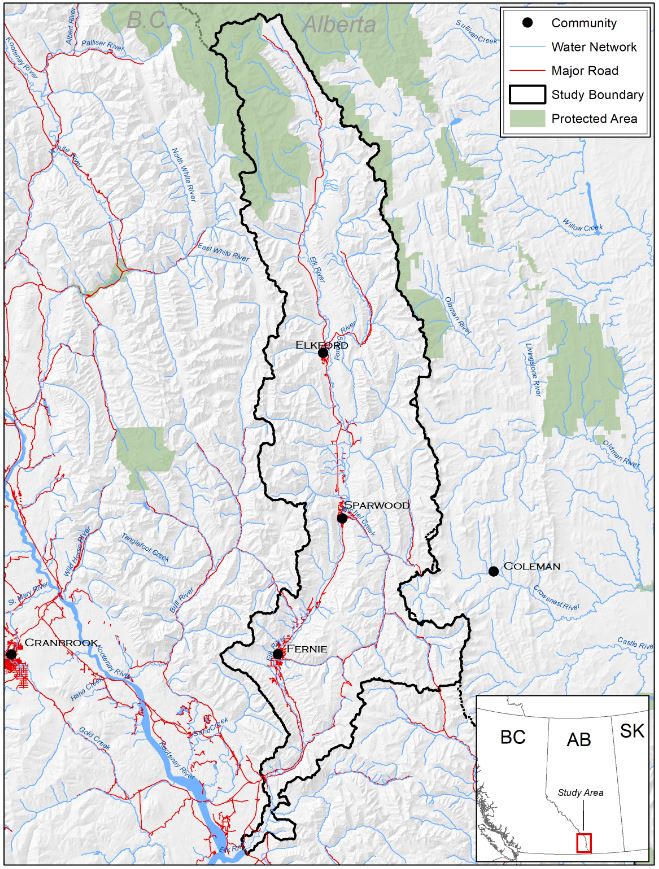Elk Valley Cumulative Effects Management Framework
Four values in the Elk Valley in the Kootenay-Boundary Region are being assessed under British Columbia’s Cumulative Effects Framework:
- Aquatic Ecosystems (Riparian Habitat and Westslope Cutthroat Trout)
- Old and Mature Forest
- Grizzly Bear
- Bighorn Sheep
Project Location
The Elk Valley is situated within the Kootenay-Boundary Region in southeastern British Columbia. The spatial boundary of the Elk Valley Cumulative Effects Management Framework (EV-CEMF) falls within part of the Ktunaxa’s traditional territory known as Qukin ʔamakʔis, or Raven’s Land, extending from the headwaters of the Elk River downstream to the town of Elko, covering an area of approximately 3,568 km2. This region is heterogeneous with an array of different ecosystems. Ktunaxa knowledge holders recognize the importance of vegetation for human use, and as habitat for other living things within Qukin ʔamakʔis. The ecological, cultural, and social values associated with the diverse ecosystems in the Elk Valley form the foundation for assessing cumulative effects in this unique landscape.
Project Background
First Nations, stakeholders, proponents, and provincial and municipal governments have become increasingly aware of the need to effectively assess and manage cumulative effects in the Elk Valley. This region has been impacted by historic and current coal operations and other pressures such as forestry operations, wildfire, residential development, recreational activities and transportation. As part of the Provincial Cumulative Effects Framework, the Elk Valley Cumulative Effects Management Framework (EV-CEMF) aims to assess the historic, current, and potential future conditions of selected valued components and to support natural resource management decisions within the region.
As a condition in the Environmental Assessment Certificate for the Line Creek coal operation expansion, Teck Coal Ltd. and the Ktunaxa Nation Council (KNC) held a multi-stakeholder workshop to address broader cumulative landscape and land use pressures in the Elk Valley. As an outcome of this workshop, the EV-CEMF was launched. The CEMF was led by Teck Coal Ltd. and KNC until January 2015, after which leadership was transitioned to the B.C. Ministry of Forests, Lands, Natural Resource Operations and Rural Development (FLNRORD) to jointly manage with the KNC. A diverse Working Group consisting of the KNC, industry, community organizations, and provincial government ministries provide guidance and oversight on EV-CEMF activities.
Project Reports
Four valued component technical reports have been completed for Grizzly Bear, Aquatic Ecosystems (Riparian and Westslope Cutthroat Trout), Old and Mature Forest, and Bighorn Sheep. These reports describe the historical, current, and future assessment of cumulative effects in Elk Valley, as well as management and mitigation recommendations. An overarching Cumulative Effects Assessment and Management (CEAM) Report integrates the assessment results for all the valued components and prioritizes key management actions in the Elk Valley. The four technical reports and the comprehensive CEAM report have been endorsed by the Elk Valley Working Group, and will be submitted to FLNRORD Regional Executive Director and KNC for final approval.
- Report: Elk Valley Cumulative Effects Assessment and Management Report – December 2018 (PDF, 29.2MB)
- Technical Report: Bighorn Sheep Cumulative Effects Assessment Report – June 2020 (PDF, 5.4MB)
- Technical Report: Grizzly Bear Cumulative Effects Assessment Report – May 2018 (PDF, 4.1MB)
- Technical Report: Aquatic Ecosystems Cumulative Effects Assessment Report – July 2018 (PDF, 11.0MB)
- Technical Report: Old and Mature Forest Cumulative Effects Assessment Report – July 2018 (PDF, 10.1MB)
- Report: Phase 1 Elk Valley Cumulative Effects Management Report – Data and Assumption Summary – January 2021 (PDF, 998 KB)
An Implementation Plan will be developed to help identify priority actions and spatial locations for management and mitigation of cumulative effects in Elk Valley. EV-CEMF Working Group members will have a shared responsibility to help implement management and mitigation actions to address cumulative effects in the Elk Valley.
Additional Project Resources

